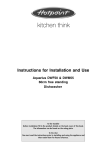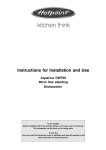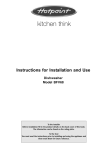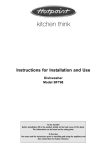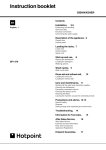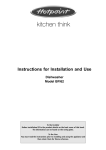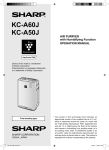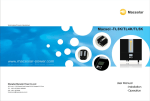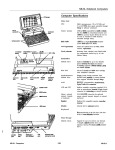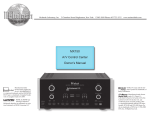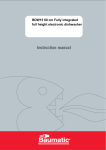Download Hotpoint DWM75 Dishwasher User Manual
Transcript
Instructions for Installation and Use Ultima DWF70 & DWM75 60cm free standing Dishwasher D ISHWASHER Contents Electrical Connection For Your Safety Installation Getting to know your Dishwasher How to use your Dishwasher Programme Chart Before Using your Dishwasher Loading your Dishwasher What Can I Wash Information for Test Labs User Quick Guide Care and Cleaning Troubleshooting Notes After Sales Service Hotpoint Guarantee Key Contacts 3 4 5 6 7 8 9-10 11 11 12 13 14 15 16-17 18 19 Back Cover Retention of this Instruction Book This Instruction Book must be kept handy for reference as it contains important details on the safe and proper use of the appliance. If you sell or pass the appliance to someone else, or move house and leave it behind, make sure this Book is also provided so the new owner can become familiar with the appliance and safety warnings. If the Book is lost or damaged a copy may be obtained from: GDA LTD., Morley Way, Peterborough, PE2 9JB 2 ARISTON DISHWASHER - Instructions for installation and use D ISHWASHER Electrical Connection WARNING: This appliance must be earthed. Fuses Safety Information Your appliance comes fitted with a plug and a 13A fuse. If you need to replace the fuse, only those rated at 13A and ASTA approved to BS1362 should be used. If you lose the fuse cover, a replacement may be obtained from your local authorised Service Centre or Electrical company. Correct replacement is identified by colour coding or the marking on base of plug. At the time of delivery... All functions of your dishwasher have been thoroughly tested at the factory. A small number of water marks may have been left as a result, they will disappear when the appliance is used for the first time. WARNING: The dishwasher must not be connected to the electricity supply while installation is being carried out. WARNING: DO NOT use the plug unless the fuse cover is fitted. - Changing the Plug Cut off and dispose of the supplied plug if it does not fit your socket. WARNING: To avoid a shock hazard DO NOT insert the discarded plug into a socket anywhere else. IMPORTANT: WIRES IN THE MAINS LEAD ARE COLOURED IN ACCORDANCE WITH THE FOLLOWING CODE: Green/Yellow Earth Blue Neutral Brown Live - If your family includes children... - If you change the plug, the colour of the wires in the mains lead may not correspond with the terminal markings in the plug, which if not coloured, could be: EARTH ‘E’ or NEUTRAL ‘N’ LIVE ‘L’ Changing the Mains Lead A lead can be ordered from Hotpoint Service UK: 08709 066 066 or Republic of Ireland: 1850 302 220 If you have damaged the existing lead or require a longer one a charge will be made. It is strongly advised that this work is carried out by a qualified electrician. If the domestic wiring includes a residual current-operated circuit breaker, ensure that it conforms to the latest regulations. This appliance should only be connected to a 230/240V AC source, via a properly installed earthed socket. Use the dishwasher solely in a domestic environment. DO NOT stand or place heavy objects on the door when it is open, this could damage the door or cause the appliance to tip forward. DO NOT allow children to play with the appliance or tamper with its controls. Keep detergents and rinse aids away from children. Keep children away from the open door of a dishwasher, there could still be some detergent left inside. CAUTION: The dishwasher meets the requirements set out by the regulations in force concerning safety and electrical equipment. Any technical checks should be conducted exclusively by a trained and authorised technician: Repairs carried out by unaithorised persons will invalidate the guarantee, as well as posing a potential hazard to the user. The manufacturer declines all responsibility for damage to persons or property resulting from failure to observe the above precautions, from tampering with even a single component or from the use of nonoriginal spare parts. ARISTON DISHWASHER - Instructions for installation and use 3 D ISHWASHER For your Safety This manual forms an integral part of the appliance. It must always be kept handy for reference. Read through all the instructions contained in this manual before using the dishwasher. Installation must be performed by a qualified technician, in compliance with the regulations in force, including the prevention and elimination of radio frequency interference. The dishwasher is designed for washing and drying dishes, any other use shall be considered improper. The manufacturer declines all responsibility for uses other than those described above. 1. 2. 3. 4. 5. 6. Seperate the various packaging materials and dispose of safely - DO NOT leave discarded packaging material around the home. After removing the packaging, check to make sure your appliance is intact. If in doubt, contact a qualified professional. DO NOT use extension leads and multiple plugs. If the electricity supply wire is not long enough, then have it replaced with one of the correct length and remember that it should be free of bends or dangerous kinks. In the event of any damage to the power cord have it replaced by a qualified technician. The mains plug must be easily accessible after installation. If the appliance is not operating properly or if maintenance operations are necessary, disconnect the dishwasher from the mains power supply (unplug it!). 7. DO NOT install outdoors, not even if the area is covered by a roof: it is extremely dangerous to leave it exposed to rain and thunderstorms. 8. If installed on a carpeted or covered floor, ensure that the openings on the underside are not obstructed. 9. Do not touch the heating element during or straight after a wash cycle. 10. If the appliance malfunctions, turn off the water inlet tap and disconnect the plug from the wall socket. Then read the section entitled "Troubleshooting". If you cannot resolve the problem, then call Hotpoint Service (see KEY CONTACTS, back page). 11. Cutlery and sharp utensils should always be inserted in random order with the blades pointing downwards (take care with knife blades). 12. For your own safety, ensure the door is closed when the dishwasher is not in use. The dishwasher is intended for use by adults. DO NOT allow children to come near or play with the controls. Keep children away from detergents and clear of the dishwasher door when open. Keep all packaging material away from children. 1. 2. 3. 4. DO NOT use solvents, such as alcohol or turpentine which may cause an explosion. DO NOT load dishes to wash that are soiled with ash, wax or paints. DO NOT lean, sit or stand on any part of the dishwasher - this could cause injury and/or damage the appliance. DO NOT drink any water residues from inside the dishwasher. 4 ARISTON DISHWASHER - Instructions for installation and use The rating plate, featuring the technical data, serial number and markings, is visibly positioned on the inner edge of thedoor. DO NOT remove the rating plate. D ISHWASHER Installation Choose where you want to install your dishwasher, you can place it so that its sides or back panel are side by side with furniture or up against the wall. The dishwasher is provided with water supply and drain hoses, which can be directed towards the left or right to facilitate appropriate installation. Levelling. Once the appliance is positioned, adjust the feet by screwing them in or out depending on how high you want it and to level it so that it is horizontal. Make sure that it is not inclined more than 2 degrees. If the appliance is level, it will help ensure its correct operation. Cold water connection. Connect the cold water supply hose, inserting the small filter supplied with the dishwasher and making sure that it is fastened tightly in place (see figure 2). If the water hoses are new or have been out of use for an extended period of time, let the water run to make sure it is clear and free of impurities before making the connection. If this precaution is not taken, the water inlet could get blocked, causing damage to your dishwasher. Drain hose connection. WARNING: Connect your dishwasher drain hose to pipes which connect to the foul drain system and not to surface water drains. IMPORTANT: For the correct operation of your dishwasher, it is essential to comply with the following information:Standpipe: Ensure that the hose is not pushed too far down the standpipe. If the end of your drain hose is fitted with ‘retaining flaps’, ensure they are inserted fully into the standpipe. This will prevent the pipe from jumping out during installation and use. Sink Waste System: For under sink drainage: Before connecting the drain hose, remove any internal restrictions This will prevent a build up of debris which could cause a blockage. Remove any restrictions from the waste spigot and ensure that the sealing bung is removed. The hose should be routed, such that it is raised to a minimum height of 800mm (31/2”). NOTE: Ensure the sink outlet pipe has a minimum diamtere of 32mm. A Remember you will be charges for a service call is a problem with your appliance is caused by incorrect installation or misuse. Fig.2 Connect to the Water Supply... - For your dishwasher to operate correctly it requires water pressures in the range of 6-150 psi (1001000KPa). Most cold water supplies will be in this range. NOTE: low water pressure will lead to excessively long fill times or no fill. - Ensure that the new hose supplied is connected and the old hose is disposed of safely. - Ensure the fill hose is only fitted to the cold water supply. DO NOT overtighten the hose connector, hand tight is sufficient. - Ensure the fill hose is not kinked. - Tap connections (if applicable): A range of adaptors are available to suit your tap. - DO NOT connect the dishwasher to a single outlet instantaneous water heater or an electric heater. DO NOT position the standpipe near an electrical outlet. ENSURE that the drain hose is not kinked and it is routed as shown in the diagram. The standpipe should have a bore of at least 38mm (11/2”). It should be installed as shown, have a trap fitted and must discharge into the same drain system as your household sink. It MUST NOT be connected to a surface water drain. 1. Untie the end of the GREY drainage hose from the rear of the appliance. 2. Reposition the ‘Hooked End Support’ as required along the GREY drainage hose. 3. If fitting an under sink waste disposal unit, cut out the membrane, bung or blanking plug. 4. Attach the GREY drainage hose to the under sink waste disposal unit securely, using the clip and rubber tube supplied. Ensure the drain hose is securely attached, to prevent it coming away while the machine is in use and causing a flood. ARISTON DISHWASHER - Instructions for installation and use 5 D ISHWASHER Getting to know your Dishwasher E. Upper basket I. F. Top spray arm J. Salt container cap G. Basket height adjuster K. Washing filter H. Lower basket L. Detergent and rinse aid dispenser Bottom spray arm M. ‘Turbo Dry’ fan The Controls A. ON-OFF display button Press this button to turn the display on. B. Display Displays the functions in progress. C. Door opening handle Use the handle to open the door. D. Start/Reset button With Start, the wash cycle begins, whereas all the settings are cleared with Reset. E. Auto Duo-Wash cycle indicator light To remind you that the Duo-Wash cycle has been set. F. Delayed Start indicator light This indicates that delayed start has been set. G. Extra drying indicator light To indicate that extra drying has been set. H. Cycle phase indicator lights Pre-Wash, Wash, Rinses, Drying. I. Wash cycle symbols A wide range of wash cycles to choose from. L. Multifunction numeric indicator Informs you the duration of the cycle, the amount of time left to wait and any error codes. M. Mode button Press this button to select the auto Duo-Wash cycle, the Delayed Start, the extra drying and the half load. N. Basket indicator Shows which basket you have selected for the Half Load. P. Cycle select button Press this button to select the desired cycle. S. ‘Selection’ button Press this button to select the following functions: Delayed Start, Extra Drying, Basket selection. T. Low salt indicator light This light tells you that is is time to add more salt. U. Low rinse aid indicator light This light tells you that it is time to add more rinse aid. Q. Water leak indicator light To warn you of a water leak. I E F H G N T U Q L This dishwasher conforms to the following European Community Directives: Te c hnic a l C ha ra c te ris tic s W idt h 6 0 cm De pt h 6 0 cm He ight 8 5 cm C apacit y up t o 14 place s e t t ings Mains W at e r Pre s s ure 30 KPa • 1MPa ( 0,3 Po we r V o lt age s e e rat ing plat e To t al abs o rbe r po we r s e e rat ing plat e F us e s e e rat ing plat e 6 ARISTON DISHWASHER - Instructions for installation and use 10 bar) 73/23/EEC (Low Voltage) and subsequent amendments; • 89/336/EEC (Electromagnetic Compatibility) and subsequent amendments; D ISHWASHER How to use your Dishwasher First of all. - Plug in and switch on. - Turn on the water supply tap completely. - Add the correct amount of detergent. - Load the baskets correctly. - Check that the spray arms rotate freely. - Close the door securely. - Press the Stand-by button "A".The display turns on and 4 dashes appear, these indicate that the dishwasher is now awaiting instructions. Select the wash cycle. Select the wash cycle by pressing button "P". Each time you press the button, a beep will sound and the corresponding symbols will light up in sequence. Select the wash cycle most suitable for the type of dishes to wash (see ‘Programme Chart’). Press and hold the Start button "D" for a few seconds and the wash cycle begins. If you left the door open, the word ‘DOOR’ will be displayed - shut the door and press the Start button again. A beep sounds: the wash cycle has started and only the symbol corresponding to the selected wash cycle is displayed. You can see the amount of time left until the end of the wash cycle on the counter "L". - Do not expect a precise countdown as the wash cycle starts with an estimated cycle time and the sensor automatically updates this as the cycle progresses (time would be affected by such things as water temperature and degree of soiling). Have you left the dishwasher door open? The word ‘DOOR’ will flash up on the display. Shut the dishwasher door and the selected wash cycle will start. Indicator lights. Cycle phase indicator lights "M" keep you informed. Each will light up to show you which cycle phase is in progress: Pre-Wash, Wash, Rinse or Drying. Modifying a wash cycle in progress. If you have chosen the wrong cycle - You can modify the wash cycle, if it has only just started. Keep the Reset button "D" pressed in for a few seconds, a prolonged beep will sound, followed by 3 short beeps. The wash cycle symbol will go out and 4 dashes appear to show that all settings have been cancelled. You are now able to reselect the correct wash cycle that you require. You've left out a dish? Interrupt the wash cycle by pressing the Stand-by button "A". Open the door and insert the dish you had forgotten, close the door and press the same button again. The cycle will start up from where you interrupted it. Cycle end The end of the wash cycle is indicated by 2 short beeps and the word ‘END’ flashes up on the display. Turn the display off by pressing the Stand-by button "A". Switch off and disconnect from the electricity supply. Turn off the water tap. Wait a few minutes before unloading the dishes: they are very hot! If you wait a little while, they dry better due to the steam. Empty the lower basket first. Ensure the wash cycle has ended before attempting to remove any dishes. Delaying the start of a programme. When you have loaded the dishes, you can choose when to start your dishwasher before setting the wash cycle desired. Press button "M" (Mode) and then select the symbol corresponding to the Delayed Start The rectangle alongside will darken to show selection. Now press button “S” to select the delayed start by 1 to 24 hours. If you press this button again, the word ‘OFF’ is displayed (no selection made). Each time the button is pressed, a beep will sound - Once you have made your selection make sure the door is shut and press the Start button "D". The countdown to the start is displayed. When this time elapses, the wash cycle begins and the time left will come up in the display. Have you changed your mind? If you decide you require a different delay start period, press the "M" (Mode) and “S” (Select) buttons and make a different selection. If you want to cancel the delay start and start the selected wash cycle immediately, press the “S” (Select) button repeatedly until it is set to zero. The indicator will turn off. The delayed start is also reset automatically, should you fail to select a wash cycle within 15 seconds. Duo-Wash cycle This is a special cycle that runs a different wash on the two basket positions. Upper basket: delicate, for glassware and glasses. Lower basket: heavy duty, for saucepans and frying pans. Press button "M" (Mode) and then select the symbol corresponding to Duo-Wash and press button "S" (Select) ‘on’ means it is selected and the rectangle alongside it will light up, whereas ‘off’ means it is disabled. After approximately 5 seconds you will automatically quit the menu. Now press Start and the wash cycle start is indicated by a beep. Half load. This option is available with all wash cycles. Your dishwasher also allows you to wash half a load (using one basket), to save water , electricity and detergent (use only half the amount). Press button "M" (Mode) repeatedly until symbol "N" is selected, the corresponding rectangle will light up. Using button “S” (Select) you can decide to wash a half-load on either: The upper basket or the lower basket Each time you press the button you will hear a beep and the corresponding symbol will light up. When no symbol is lit it means no selection has been made. Once you have made the selection, press Start to begin the wash cycle. “Extra” drying If you want your dishes to be perfectly dry: Open the door, turn knob “M” to the Reset position, select the basket/s to be used and delayed start if required. Start the wash cycle as normal. Indicator “G” will show symbol when it has reached the drying phase. The symbol will flash for approximately 4 seconds and the word OFF appears on the display (extra drying disabled). If you immediately press button “I”, you will hear a prolonged beep and the word ON will appear on the display and extra drying has been selected. Once you have completed all your selections, shut the door. You will hear a beep and the wash cycle will start, either immediately or after the delayed start if selected. Remember that with extra drying selected the programme will last longer. There's been a power failure or you opened the dishwasher door The wash cycle stops and then restarts when the electricity comes back on or when you close the door. For your own safety, ensure the door is closed when the dishwasher is not in use. ARISTON DISHWASHER - Instructions for installation and use 7 D ISHWASHER Programme Chart Select the most suitable programme for the type of dishes and how dirty they are. To select the wash programme see the chart below: Salt, rinse aid, the right amount of detergent and the correct wash cycle... This is the formula to get the best results and to keep your dishwasher in shape. Note: In the ‘Aquasensor’ wash cycles, the cycles could undergo some modifications due to the intervention of the sensor which evaluates how dirty the dishes are and optimises the cycle in accordance. CYCLE INTENS IVE NORMAL EC O FAS T CYCLE S ELECTION INS TRUCTIONS V e ry dirty dis he s and pans ( NOT to be us e d fo r de licate ite ms ) CYCLE DES CRIPTION Pre -was h with ho t wate r at 40 C Ex te nde d was h at 65 C 2 co ld rins e s Ho t rins e at 65 C Dry ing Cy cle fo r no rmally dirty pans and Pre -was h with co ld wate r Sho rt was h at 55 C - Cold rinse dis he s . Standard daily cy cle . Ho t rins e at 70 C Dry ing Env iro nme ntally frie ndly cy cle , with lo w e ne rgy co ns umptio n le v e ls , s uitable fo r no rmally dirty pans and dis he s . 2 co ld pre -was he s Ex te nde d was h at 45 C Ho t rins e at 65 C Dry ing Eco no mic and fas t cy cle to be us e d fo r s lightly dirty dis he s . Run cy cle imme diate ly afte r us e . W itho ut dry ing e x ce pt whe n the e x tra dry ing o ptio n has be e n s e le cte d. Sho rt was h at 40 C Co ld rins e o r Ho t rins e , if the e x tra dry ing o ptio n has be e n s e le cte d. ‘Aquasensor’ wash cycles... This means that your dishwasher is equipped with a sensor which evaluates how dirty your dishes are and allows these wash cycles to adjust automatically to provide you with a more efficient and economic wash cycle. DETERGENT FOR RINS E AID WAS H CYCLE DURARTION PRE-WAS H & WAS H (witho ut e xtra drying) in minute s 5 + 25g * 120 5 + 25g * 72 5 + 25g * 120 25g 26 PRE-WAS H Pre liminary was h cy cle fo r dis he s Sho rt co ld was h to pre v e nt fo o d while awaiting co mple tio n o f the fro m dry ing o nto the dis he s . lo ad with the dis he s fro m the ne x t me al. DELICATES Spe cial cy cle to be us e d fo r mo re de licate ite ms which are s e ns itiv e to high te mpe rature s . Run cy cle imme diate ly afte r us e . W as h at 50 C Rrins e at 45 C Ho t rins e at 65 C Dry ing S PECIAL GUES T Ho t rins e at 65 C Dry ing Rins e and dry ing cy cle fo r dis he s that are s e ldo m us e d and are o nly dus ty . 12 25g * 96 * 36 * 108 OPTIONAL WAS H CYCLE AUTO DUO W as h diffe re ntiate d o n the two WAS H racks . De licate fo r glas s ware and glas s e s o n the uppe r rack and he av y duty fo r the pans o n the lo we r rack. Co ld pre -was h W as h at 50 C Luke warm rins e at 45 C Ho t rins e at 65 C Dry ing 5 + 25g To optimise wash performance and save on energy, try to use the dishwasher with a full wash load. If it takes some time to fill your dishwasher, use the pre-wash to avoid caked on food and build up of bad odours. 8 ARISTON DISHWASHER - Instructions for installation and use D ISHWASHER Before Using your Dishwasher To prevent rust from forming, load the salt just before beginning a wash cycle. Adjusting the water softener. Water hardness varies according to where you live. If the water in your home is hard, without water softening, incrustations would form on your dishes. Your dishwasher is fitted with a water softener which uses special salt to get rid of limescale in the water. Your dishwasher can adjust its salt consumption according to the hardness of the water in your home. This way, you can optimise and customise your dishwasher's salt consumption. To adjust salt consumption, do as follows: 1. Unscrew the salt container cap 2. There is an arrow on the neck of the container (see figure): if necessary, turn the arrow anticlockwise from the "-" setting to the "+" setting. Select the arrow position depending on the water hardness, referring to the table. W aterH ardness m m ol/l Selector position Salt consu m ption (gram s/ cycle) 0 17 0 1,7 / 0 / 14 36 18 44 1,8 4,4 "" 20 60 36 71 45 M ED 40 40 "+" 60 25 Clarke degrees °fH 0 14 >71 89 4,5 > 89 8,9 > 8,9 A utono my (cycles\2 kg) IMPORTANT: Only use recommended dishwasher salt. DO NOT use everyday table salt, cooking salt, as they containe insoluable substances which could harm the dishwasher. You don't know how hard the water in your home is? Ask the company that supplies water in your area. Salt Filling the salt container. When to add salt: Always use salt which is intended for dishwasher use. The salt container is situated underneath the lower basket, fill it up as follows: 1.Pull out the lower basket completely, unscrew and remove the container cap 2. If it is the first time you add the salt, first fill the container up with water (you won't have to do this again next time) 3. Put the dishwasher funnel on the hole and pour in approximately two kilos of salt. It is normal that some water comes out of the container. 4. Screw the cap back in place carefully. The salt container should be filled up when the low salt indicator light “T” flashes on the control panel. When you have loaded salt for the first time, it is normal for the low salt indicator light to stay on for at least 5 consecutive cycles. IMPORTANT NOTICE: 3 in 1 dishwasher tablets are now available. These combine detergent, salt and rinse aid ALL IN ONE. If the water in your area is hard or very hard, we still recommend you add salt to the salt container to prevent white streaks on your dishes and in the dishwashers interior. Add rinse aid to the dispenser, only if you are dissatisfied with the results. In all cases, please read the manufacturers instructions on the packet. If you are only using the 3 in 1 products, after a number of cycles it is normal for the salt and rinse aid indicator lights to flash permanently. WARNING: DO NOT pour detergent into the special salt container. This will destroy the water softener. ARISTON DISHWASHER - Instructions for installation and use 9 D ISHWASHER Before Using your Dishwasher The detergent • Use the right amount of detergent (see programme chart). • Store your detergent and rinse aid in a cool, dry place, safely away from children. Each time you load the dishwasher, add detergergent. Pour dishwasher detergent into thedispenser on the inside of the door. Adding detergent To open lid A, press button B. The detergent should be put into the two containers C and D. If using a tablet, put it in container "D". Now you can close the lid: press it down until you hear it click. If it won't close Check whether there is any detergent residue on the edges of the dispenser. Remove the excess. We recommend Glist 3 in 1 for use in all Hotpoint dishwashers... Brilliant cleaning is guaranteed with Glist 3 in 1. Hotpoint only recommends Glist 3 in 1 Dishwasher tablets to give outstanding cleaning and care. It is important to use detergent specially designed for domestic dishwashers. (Always follow the manufacturers instructions.) Glist 3 in 1 advanced dishwasher tablets with active enzymes are the ideal way to protect and care for your dishwasher, while getting your dishes and glasses sparking clean. Softer Water: Built in salt action softens water, helping to prevent the build up of limescale in the dishwasher and improve the cleaning result*. Cleaner Dishes: With unique active enzymes in the cleaning phase Glist 3 in 1 breaks down even the hard to shift foodstuffs and grease, leaving the dishes spotless and the dishwasher clean too. Sparkling Results: The built-in Glist rinse agent ensures the dishes and glasses are free from water marks and smears. *If you live in an area particularly prone to very hard water ( 35°f) Glist and Hotpoint recommend that you continue to keep your dishwasher salt topped up. If you have any questions regarding Glist 3 in 1, please contact the hotline on 0800 216 730. Rinse aid. Rinse aid makes dishes sparkle more as it improves their drying. The rinse aid container is situated on the inside of the door. You should fill the rinse aid container when indicator D lights up on the container (see right) and the rinse aid indicator light "U" on the control panel flashes. Adding rinse aid. To open the dispenser, turn cap C anticlockwise. Take care when you pour in the rinse aid to avoid it overflowing. You can regulate the amount of rinse aid used by the dishwasher, move the adjuster F which you will find under lid C. You can choose from six different positions. It is normally set to 4. 10 ARISTON DISHWASHER - Instructions for installation and use - The amount of rinse aid needs to be increased if the dishes appear dull or you can see circular stains. - The amount of rinse aid needs to be reduced if the dishes are sticky or you can see white streaks. D ISHWASHER Loading your Dishwasher First of all. Before placing dishes in the baskets, remove all course food remains. This avoids blocking the filter, which would reduce the efficiency of the wash. If saucepans and frying pans are very dirty, allow them to soak before being washed. To make it easier to load your dishes, pull the baskets out. Multisystem baskets The dishwasher is fitted with upper, lower and cutlery baskets. They provide greater flexibility for loading dishes, making them more suitable for your specific needs. The basket handles can be removed for cleaning. Pull out the two fastening plugs, remove the handles and rinse under running water. Replace the handles fixing them in place with the two fastening plugs. What goes into the upper basket? Place delicate and lightweight dishes in the upper basket: glasses, tea cups and coffee cups, saucers and plates - shallow salad bowls, slightly dirty frying pans and shallow pans. Position lightweight dishes in such a way as to avoid their being moved by the spray of water. The dishwasher can also be equipped with one or two tip up compartments onto which you can place mugs and cups, as well as long sharp knives and serving cutlery. After loading the dishes, remember to check that the spray arms can turn freely without hitting against any dishes. How to adjust the upper basket. The upper basket can be set in high or low position to enable you to organise your dishes effortlessly. There are two handles on the sides of the upper basket, use these to adjust its height (see fig.C). What goes into the lower basket? We recommend you place the most difficult dishes to wash into the lower basket: saucepans, lids, soup dishes and plates (a load example is shown in the photo). • Serving dishes and large lids: place them on the sides of the basket. • Saucepans, salad bowls: must always be placed upside down • Very deep dishes: place them obliquely, thus allowing water to run down them and cleaning them better • Glasses and cups: position them as shown in load example photo. The cutlery baskets can be split up by pulling out the handle and removing the metal clip that keeps the two parts joined together. When you only have a little cutlery to wash you can use just half the basket, save space for other crockery or place the other half in the upper basket instead (see figures A and B). This basket is equipped with two removable grids. Cutlery and sharp utensils should always be inserted in random order with the blades pointing downwards (take care with knife blades). Position them so that they don’t touch. In this specific model, the cutlery basket is fitted with two detachable side compartments, as shown in figure A1, which can be hooked on either the upper or lower basket as required. Load examples lower basket upper basket A A1 What can I Wash Items not suitable for the dishwasher: • Cutlery and tableware made from wood or part wood - They may become faded and unsightly in appearance. • Avoid washing horn handled and bronze cutlery in the machine. • Delicate/decorative glassware and vases, special antique or irreplaceable china - the decorative patterns printed on these items will not be dishwasher proof. • Plastic objects that are not resistant to hot water. • Copper and Pewter utensils. Aluminium and Sliver objects. • Some types of glass can become opaque in appearance after they have been washed too many times in a dishwasher. • Highly absorbent materials such as sponges and towels should never be placed in a dishwasher. • If in any doubt, check with the manufacturer on items suitability for dishwasher’s. WARNING: Dishes or cutlery soiled with tobacco ash, wax, lubricating grease or paint should not be put in the dishwasher. Our recommendation: In future, only purchase table or kitchenware that has been confirmed - dishwasher proof. ARISTON DISHWASHER - Instructions for installation and use 11 D ISHWASHER INFORMATION FOR TEST LABS Load for 12 Standard Settings tests (upper basket at top position) 3 12 C 12 B A 1 h D 9 4 i A k C g g C e e 2 f g e g 6 9 3 lower basket 5 1 2 LO WER BAS KET upper basket 3 UPPER BAS KET TY PE ITEM DIAMETER / V O LUME ( appro x imat e ly ) TY PE ITEM DIAMETER / V O LUME ( appro x imat e ly ) A s o up dis h 2 3 cm e cu p 0.20 l. B dinne r plat e 2 6 cm f s e rv ing bo wl 1 9 cm C de s s e rt plat e 1 9 cm g glas s 250 ml. D o v al plat t e r 3 5 cm h s a u ce r 1 4 cm k s e rv ing bo wl 1 3 cm j s e rv ing bo wl 1 6 cm The rinse aid There are 6 different settings; the normal dosage setting is 5. 7 8 2 3 1 6 4 5 5 5 5 5 5 5 5 5 5 5 3 3 3 3 5 3 3 3 3 3 3 3 7 1 1 1 1 1 1 1 1 1 8 4 2 5 3 7 1 1 1 6 4 4 4 4 4 4 4 4 4 2 2 2 2 2 2 2 2 2 2 4 Loading the detergent To open lid "A", press button "B". The cleaning detergent should be introduced into the three containers “1”, “2”and “3”. (see table below) 4 2 This basket is equipped with tworemovablegrids.Cutlery and sharp utensils should always be inserted in randomorderwiththeblades pointing downwards (take care with knife blades). Position them so that they don’t touch. Press the “extra dry” button (depending on Model). Don’t press the “extra dry” button only, for free-standing dishwashers with “turbo-dry” fan, see features in the ‘Getting to Know Your Dishwasher’ section of this instruction book. Cycle EN 50242 IEC/ DIN ❉ Eco wash Intensive wash Total detergent 30 gr. 30 gr. 12 ARISTON DISHWASHER - Instructions for installation and use Comp.1 Comp.2 Comp.3 25 30 5 D ISHWASHER User Quick Guide ARISTON DISHWASHER - Instructions for installation and use 13 D ISHWASHER Care and Cleaning Unplug the appliance. Before carrying out any cleaning or maintenance on the dishwasher, always remove the plug from the electricity socket. Cleaning the spray arms. Food residue may become encrusted onto the spray arms and block the holes where water comes out. Check the spray arms regularly and clean them once in a while. After every wash. When the wash cycle has ended, always remember to turn off the water supply tap and to leave the appliance door ajar. This way, moisture and bad odours will not be trapped inside. The filter assembly • If you want consistent good results from your dishwasher, you need to clean the filter assembly. • Remove the larger food particles trapped inside the cup “C” and the semi-circular filter A after each wash; pull the cup handle upwards to remove them. Just rinse them under running water. • The entire filter assembly should becleanedthoroughlyonceamonth: cup C + semi-circular filter A + cylindrical filter B. Rotate filter “B” anticlockwise to remove it. For cleaning, use a non metallic brush. 1 B 2 A Cleaning the Water Inlet Filter Periodically clean the water inlet filter (see figure 2 under "Installation") located on the outlet of the water supply tap. After turning off the water tap, unscrew the end of the water supply hose, remove the filter and cleanitcarefullyunderrunningwater. Then, return the filter to its place and tighten the water supply hose back into position. The seals. One of the factors that cause unpleasant odours to form inside the dishwasher is food that remains trapped in the seals. Periodic cleaning using a damp sponge will prevent this from occurring. C Reassemble the filter parts (as shown in the figure) and reinsert the whole assembly into the dishwasher. Position it into its housing and press downwards. The dishwasher is not to be used without filters. Improper replacement of the filters may reduce the efficiency of the wash and even damage your dishwasher. 14 ARISTON DISHWASHER - Instructions for installation and use DO NOT use solvents or abrasives to clean the exterior and rubber parts of your appliance, do not use solvents or abrasive cleaning products. Use a cloth dampened with lukewarm soapy water only. If there are any stains on the surface of the appliance interior, use a cloth dampened with water and a little white vinegar, or a cleaning product specifically made for dishwashers. Going away If the dishwasher is not going to be used for some time, carry out the following: • run a cycle with the dishwasher empty. • switch off at the electrical socket and unplug. • turn off the water supply tap, disconnect the inlet hose and allow to drain. • fill the rinse aid dispenser. • leave the door ajar, to prevent the build up of unpleasant odours inside the dishwasher. Before using the dishwasher after a long break, plug in and switch on at the electrical socket. Reconnect the inlet hose and turn on the water supply tap. Check there are no deposits of rust inside the water pipe, if there are allow water to run from the supply tap for a few minutes. Disconnecting the dishwasher. Whendisconnectingthedishwasher it is important that tasks are carried out in the correct sequence. • switch off at the mains and remove the plug from the socket. • turn off the water supply. • disconnect drain and water inlet hose. • pull out the dishwasher, carefully, withdrawing hoses at the same time. Moving the appliance. Drain water from the dishwasher. Secure all loose parts. Only transport in an upright position. • If not kept upright during transport, any water remaining inside may seep into the control module and cause subsequent errors with programme functions. D ISHWASHER Troubleshooting Caution - Do not forget that repairs should be carried out by a qualified specialist. Improper repairs can lead to considerable equipment damage, as well as danger to the user. - The dishwasher must first be disconnected from the electricity supply before any repairs or other work can be carried out. Switch off at the mains socket and water supply and remove the plug. Resolving minor problems yourself. Experience has shown that you can resolve most problems that arise during normal daily usage yourself, without having to call out a service engineer. Not only does this save costs but it also means the appliance is available for use again that much sooner. The following list of common occurences and their remedies should help you identify the causes of most problems. If the dishwasher won't start, check... Is the dishwasher plugged in at the electricity socket and switched on? Is there a power failure, check other appliances. Check the fuse. Is the water supply tap turned on? Is the water inlet hose connected properly? Is the pressure of the water supply sufficient? Is the inlet hose kinked? Is the filter on the water supply hose blocked? Is the dishwasher door not closed properly? If water remains inside the dishwasher, check... the drain hose is not kinked. the drain syphon is not obstructed. the dishwasher filters are not clogged. If the dishes are not being cleaned properly, check... the correct amount of detergent has been added. there is regenerating salt in the salt container. the dishes have been loaded correctly. the selected programme is suitable for the type of dishes and the degree of soiling. all filters are clean and positioned correctly. the spray arm nozzles are not obstructed. there is nothing obstructing the rotation of the spray arms. Detergent compartment lid can not be closed, check... has the compartment been overfilled? is the mechanism clogged with remnants of detergent? If the dishes fail to dry or remain dirty, check... there is rinse aid inside the rinse aid container. the rinse aid dispenser setting is correct. the detergent being used is of good quality and has not lost its effectiveness (for example, through incorrect storage, with the box left open). If the dishes show signs of streaking, staining etc. check... the rinse aid dispenser setting is not set too high. If there are visible traces of rust inside the tank, check... the cap off the salt container is securely closed and that the water softner setting is correct. the correct amount of detergent is being used. Certain detergents can be more corrosive than others. the tank is made of steel and therefore any rust marks are due to external elements (fragments of rust from the tank pipes, pots, cutlery etc.) Special products are commercially available to remove such marks. ...During washing Unusualamountoffoamiscreated: - Has the correct detergent been used. Dishwasher stops suddenly during a wash cycle: - There has been a power cut. - Water supply has been interrupted. Knocking sound can be heard inside the dishwasher: - A spray arm is knocking against dishes. Rattling sound an be heard inside the dishwasher: - Crockery has not been stacked properly. Knocking sound can be heard coming from the inlet valves: - This is caused by the way the water pipes are laid ad it has no effect upon the way the dishwasher functions. Error messages Your dishwasher is equipped with a safety system which is able to detect operating faults. These faults flash up on the display by several codes consisting of letters and numbers. Take a note of the codes, turn the appliance off and call Hotpoint Service for technical assistance (see back page). If after all the checks, the appliance still does not operate or the problem persists, call Hotpoint Service (see KEY CONTACTS, back page) and inform them of: - the type of problem -theabbreviationofthemodel name (Mod.) and the relative numbers (S/ N) written on the rating plate located on the inner edge of the door. Tap off alarm If the H2O code is flashing on the display with a long series of prolonged beeps, it means you have forgotten to turn the water tap on. Turn on the water tap and the dishwasher will start after a few minutes. If you are not there when the H2O code appears, the appliance will switch to alarm mode and the code AL06 will flash on the display. Turn the dishwasher off by keeping the Stand-by button pressed in, check the water supply and turn on the water tap, waitapproximately20secondsbeforeturning appliance back on by pressing the Stand-by button again. Repeat your wash cycle selections and press the Start button. Switch off at the mains socket and remove the plug. Turn off the water supply. Clogged filter alarm If the dishwasher is blocked and code AL05 appears, this means the filter is clogged. Turn the display off by keeping the Standby button pressed in, follow cleaning instruction in the ‘Care and Cleaning’ section. When the filter is back in position, turn the dishwasher back on. Repeat your wash cycle selections and press the Start button. Clogged filter alarm If the water leak indicator light “Q”flashes, this means the dishwasher has a leak. Switch off and disconnect from the electricity supply. Check for leaks in the tap and fill hose connections. ARISTON DISHWASHER - Instructions for installation and use 15 D ISHWASHER Notes 16 ARISTON DISHWASHER - Instructions for installation and use D ISHWASHER Notes ARISTON DISHWASHER - Instructions for installation and use 17 After Sales Service "No company is better positioned to offer an after sales service on a Hotpoint appliance than us - the manufacturer" As part of our commitment to you, all Hotpoint appliances have the added benefit of a fully inclusive parts and labour guarantee for the first 12 months. In addition to this you also have the advantage of free replacement parts for the first 5 years when fitted by a Hotpoint engineer. When the 12 months parts and labour guarantee expires we offer the following after sales service options: Repair Service and Information Help Desk UK: 08709 066066 www.theservicecentre.co.uk Republic of Ireland: 1850 302 200 Note: Our operators will require the Model number and the Serial number of your appliance Available 364 days a year with a fast, effective and value for money service. We have the largest white goods repair service in the UK with over 900 of our own fully trained engineers. All repairs include a parts and labour guarantee for 12 months from the date of the repair. If you require any information or have any questions about your appliance, our operators are on hand with help and advice. All this ensures that you will receive the best available after sales service possible. Extended Warranties UK: 08709 088 088 www.theservicecentre.co.uk Republic of Ireland: 1850 502 200 Whether you have just one or a number of Hotpoint appliances in your kitchen, we offer two service cover plans to give you total peace of mind. Repair Protection Plan FREE service repairs for a single Hotpoint appliance during the period of cover. Kitchen Cover FREE service repairs for all your Hotpoint appliances less than 8 years old. Genuine Parts and AccessoriesUK: 08709 077 077 www.theservicecentre.co.uk Republic of Ireland: (01) 842 6836 A wide range of genuine parts and accessories are available from our hotline or through our web site. Genuine parts and accessories, extended warranties and service repairs are all available on our web-site at: www.theservicecentre.co.uk 18 Guarantee "Satisfaction guaranteed or your money back" We give you a unique 'satisfaction guaranteed' promise - valid for 90 days - after you have purchased your Hotpoint appliance. If there is a technical problem simply call Hotpoint Repair service or visit our web-site at www.theservicecentre.co.uk and where necessary, we will arrange for an engineer to call. If the technical problem is not resolved under this guarantee, we will replace your machine or, if you prefer, give you your money back. All Hotpoint appliances carry a fully inclusive 12 month parts and labour guarantee as well as free replacement parts for the first 5 years (except microwaves, selected integrated appliances and cooker hoods, which have a one year guarantee) provided that they are fitted by a Hotpoint engineer. Guarantee terms and conditions Your guarantee is only applicable in the United Kingdom or Republic of Ireland and is subject to the following provisions that your appliance: Has been installed and used correctly in accordance with this instruction booklet. Has been used solely for domestic purposes and is located on domestic premises (ie. not for commercial or trade use). Has been properly connected to a suitable electrical supply voltage as stated on the appliance rating plate. Has not been subject to misuse, accident, modified or repaired by anyone other than one of our own service engineers. For pre purchase information on any other Hotpoint product call: 08701 50 60 70 or visit: www.hotpoint.co.uk Recycling & Disposal Information As part of Hotpoint's continued commitment to helping the environment, Hotpoint reserves the right to use quality recycled components to keep down customer costs and minimise material wastage. Please dispose of packaging and old appliances carefully. To minimise risk of injury to children, remove the door, plug and cut mains cable off flush with the appliance. Dispose of these parts separately to ensure that the appliance can no longer be plugged into a mains socket and the door cannot be locked shut. 19 Key Contacts After Sales Service Over 900 trained specialists, directly employed by us, ensure that you can have complete confidence in both the appliances and services we offer. Repair Service and Information Desk UK: 08709 066 066 (Open 8 to 8 Mon - Fri, 8 to 6 Sat, 10 to 4 Sun & Bank Holidays) www.theservicecentre.co.uk Republic of Ireland: 1850 302 200 Note: Our operators will require the following information: Model number: Serial number: Extended Warranties UK: 08709 088 088 (Open 8 to 8 Mon - Sun) www.theservicecentre.co.uk Republic of Ireland: 1850 502 200 Genuine Parts and Accessories UK: 08709 077 077 (Open 8-30 to 5-30 Mon - Fri & 9 to 12 Sat) www.theservicecentre.co.uk Republic of Ireland: (01) 842 6836 General Domestic Appliances Limited, Morley Way, Peterborough, PE2 9JB. 195039357.00 June 2003 Part no. FP199 - 01




















